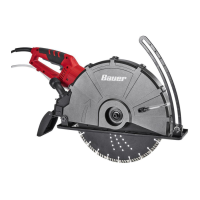Page 6 For technical questions, please call 1-888-866-5797. Item 58215
SAFETY OPERATION MAINTENANCESETUP
Kickback and Related Warnings
Kickback is a sudden reaction to a pinched or snagged rotating wheel. Pinching or snagging
causes rapid stalling of the rotating wheel which in turn causes the uncontrolled power tool to
be forced in the direction opposite of the wheel's rotation at the point of the binding.
For example, if an abrasive wheel is snagged or pinched by the workpiece, the edge of the wheel that
is entering into the pinch point can dig into the surface of the material causing the wheel to climb out or
kick out. The wheel may either jump toward or away from the operator, depending on direction of the
wheel's movement at the point of pinching. Abrasive wheels may also break under these conditions.
Kickback is the result of power tool misuse and/or incorrect operating procedures or
conditions and can be avoided by taking proper precautions as given below.
1. Maintain a firm grip on the power tool and
position your body and arm to allow you to
resist kickback forces. Always use auxiliary
handle, if provided, for maximum control over
kickback or torque reaction during start-up. The
operator can control torque reactions or kickback
forces, if proper precautions are taken.
2. Never place your hand near the rotating accessory.
Accessory may kickback over your hand.
3. Do not position your body in line with the
rotating wheel. Kickback will propel the
tool in direction opposite to the wheel's
movement at the point of snagging.
4. Use special care when working corners, sharp
edges etc. Avoid bouncing and snagging the
accessory. Corners, sharp edges or bouncing
have a tendency to snag the rotating accessory
and cause loss of control or kickback.
5. Do not attach a saw chain, woodcarving blade,
segmented diamond wheel with a peripheral gap
greater than 10mm or toothed saw blade. Such
blades create frequent kickback and loss of control.
6. Do not "jam" the wheel or apply excessive
pressure. Do not attempt to make an excessive
depth of cut. Overstressing the wheel increases
the loading and susceptibility to twisting
or binding of the wheel in the cut and the
possibility of kickback or wheel breakage.
7. When wheel is binding or when interrupting a cut for
any reason, switch off the power tool and hold the
power tool motionless until the wheel comes to a
complete stop. Never attempt to remove the wheel
from the cut while the wheel is in motion otherwise
kickback may occur. Investigate and take corrective
action to eliminate the cause of wheel binding.
8. Do not restart the cutting operation in the workpiece.
Let the wheel reach full speed and carefully re-enter
the cut. The wheel may bind, walk up or kickback
if the power tool is restarted in the workpiece.
9. Support panels or any oversized workpiece to
minimize the risk of wheel pinching and kickback.
Large workpieces tend to sag under their own
weight. Supports must be placed under the
workpiece near the line of cut and near the edge
of the workpiece on both sides of the wheel.
10. Use extra caution when making a "pocket cut" into
existing walls or other blind areas. The protruding
wheel may cut gas or water pipes, electrical
wiring or objects that can cause kickback.
Vibration Safety
This tool vibrates during use. Repeated or long-term exposure to vibration may cause temporary or permanent
physical injury, particularly to the hands, arms and shoulders. To reduce the risk of vibration-related injury:
1. Anyone using vibrating tools regularly or for
an extended period should first be examined
by a doctor and then have regular medical
check-ups to ensure medical problems
are not being caused or worsened from
use. Pregnant women or people who have
impaired blood circulation to the hand, past hand
injuries, nervous system disorders, diabetes,
or Raynaud’s Disease should not use this tool.
If you feel any symptoms related to vibration (such
as tingling, numbness, and white or blue fingers),
seek medical advice as soon as possible.
2. Do not smoke during use. Nicotine reduces
the blood supply to the hands and fingers,
increasing the risk of vibration-related injury.
3. Wear suitable gloves to reduce the
vibration effects on the user.
4. Use tools with the lowest vibration
when there is a choice.
5. Include vibration-free periods each day of work.
6. Grip tool as lightly as possible (while still
keeping safe control of it).
Let the tool do the work.
7. To reduce vibration, maintain the tool as
explained in this manual. If any abnormal
vibration occurs, stop use immediately.
SAVE THESE INSTRUCTIONS.

